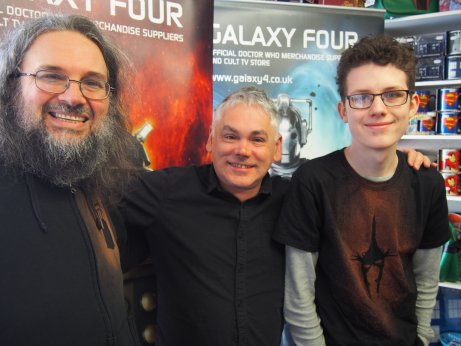Let's start with something that is a definite improvement for me, although it may not have been such a good thing in 1965: this story is "written for the trade". Now, that's a phrase from the US comic scene meaning that the story is designed to work best when read in one sitting, rather than issue-by-issue. Normally I'd be a bit more ambivalent about it; but as I've commented in my reviews of the last two stories, the constraints of a single-page-per-week format have been actively harmful recently. This story trusts that the reader will be sufficiently intrigued to keep reading even without a cliffhanger - indeed, the only cliffhanger in the whole story is at the end of the first episode - and that allows for more natural pacing. The result is the best storyline in a long time.
Of course, plot is only one aspect of a comic story, and the art goes though by far its biggest change in the series between episodes 49 and 50: Richard Jennings leaves, to be replaced by Ron Turner. This is not something you'd be likely to see in a written-for-trade comic! Turner has a more cartoon style, with thick, dark lines and deeper shadows. The results are mixed, and neither artist does the Mechanoids justice, with the worst point being a panel with the Dalek Emperor talking about their "powerul arms" beneath an image where those arms look like flimsy plastic. I do prefer Turner's spaceships but his Daleks are vastly inferior, looking as if they are sliding around in giant sardine tins. Comparing the space battles, Jennings' final panel - showing the Mechanoid ship exploding - has much more energy than the corresponding panels on Turner's first page (which also feature molten metal from a doomed saucer dripping down towards the bottom of the page, despite the absence of gravity). Overall, at present I feel that this is definitely a change for the worse.
Turning next to the dialogue, I'm afraid I have to continue my run of snarks about the over-reliance on technobabble. This really goes into overdrive here, which is a shame as it damages my ability to take the story seriously. People complain about the technobabble in Star Trek, but that show put it to much better use than David Whitaker does here. For example, the Emperor helpfully explains precisely how they scan a Daleks' mind to find out about the Mechanoids:
"This hypnotic cloud is made up of thought patterns. They make indelible pictures, stored by this Dalek in its memory retina. We have added substance particles and dimension atoms to that cloud. Watch the result on the visualiser."Thanks, yer highness! That makes it so much clearer! </sarcasm> Never mind that it is so full of nonsense phrases as to be meaningless, or even that it doesn't explain how a Dalek who has never seen a Mechanoid can remember what one looks like. The most annoying thing is that it isn't needed at all. A sentence like "scan this Dalek's brain for useful information" would do the job just as well, probably better.
Despite these flaws, the plot makes me excited for what is to come next. After all, it's the Mechanoids! Of course that revelation was going to please me, as I've known them as the Daleks' nemesis since before I saw either on screen. But more on that later...
Rating:
Comic: 4.5/10.
Published:
Dates: 11th December 1965 to 8th January 1966
Next Time:
Altered Vistas' take on Eve of War.

